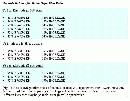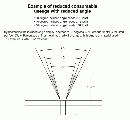 |
| |||||||||
By Ken Fisher, Manager of High Deposition Processes, Miller Electric Mfg. Co.
APPLETON, Wis. –Miller Electric Mfg. Co. has made the first meaningful breakthrough in submerged arc welding (SAW) in more than two decades with the introduction of its "variable balance AC squarewave" SAW technology. This patented technology overcomes the traditional problems or limitations of SAW with all other processes, including DC electrode positive (DCEP), DC electrode negative (DCEN) and traditional AC.
On groove welds on 1.25-in. steel plate, variable balance AC squarewave SAW increases the deposition rate up to 59 percent over DCEP using the exact same welding parameters and wire types (see Fig. 1). This enables fabricators to replace their old technology and immediately lower weld costs without time lost on developing new welding parameters (note that the joint may need re-qualification).
In applications that benefit from high travel speeds, such as a butt weld on 40 ft.-long, 1/4 in.-thick plate made with a 1/8 in. diameter electrode, variable balance AC squarewave technology provides travel speeds up to 65 in./min. This is faster than tandem arc SAW (two arcs in series) without any of the problems, initial cost, power use or consumable consumption of a two-arc system.
Other, proven benefits of a variable balance AC squarewave include:
- A guaranteed deposition increase over single wire, DCEP butt welds
- Smaller included angles and up to 42 percent lower filler metal use
- Reduced heat input for minimized warping and base metal dilution
- Simpler multiple AC torch configurations by offsetting the cycle of the variable balance AC squarewave by 60 degrees between torches
- Substantially lower power consumption and lower hookup costs because the power source uses three-phase primary power, not single-phase power
DC Limitations
Conventional DC SAW forces welding engineers and plant managers to accept a compromise. They can emphasize one of three major variables: high deposition rates, ideal penetration profiles or lower heat input.
DCEP, which preheats the plate more than the electrode, provides deeper penetration and good wetting at the toes of the weld. However, it has a lower deposition rate and higher heat input. This can be an unfavorable combination for making long welds at higher speeds, for welding plate sensitive to warping ("oil canning") and welding heat treatable materials (e.g., 4130, 4140). In the latter, excess heat may cause base metal dilution and subsequent loss of alloy properties in the weld area, which makes the weld susceptible to cracking.
DCEN can reduce base metal dilution and warping problems. However, because the heat focuses more on the electrode than the plate, the weld bead doesn't penetrate as deeply. DCEN does offer higher deposition rates, but it does not run well at lower amperage levels without sacrificing productivity.
Problems with Old AC
Despite DC inadequacies in many single-wire applications, many fabricators accepted a DC compromise because, until now, AC SAW was not an acceptable single-wire solution. AC current is attractive because it does not cause arc blow, lowers heat input to the workpiece and permits using magnetic clamps to hold the workpiece in place. Unfortunately, it has several drawbacks.
A conventional sinusoidal AC wave takes a long time, relatively speaking, to make the transition through the zero amp range. This causes arc outages and arc instability, especially on the electrode positive to electrode negative transition because current wanders as it "hunts" for the electrode. Second, a sinusoidal wave does not offer adequate dwell time at peak amperages (see Fig. 2). The arc cannot direct sufficient heat into the plate for penetration nor melt the electrode fast enough for good deposition. As a result of these limitations, the industry typically avoids single wire AC SAW. Generally, its use is limited to tandem arc or multiple torch applications.
New Power Source Technology
Miller's new SAW technology makes previous perceptions of AC SAW technology obsolete. The first breakthrough occurred more than 15 years ago when Miller invented an AC squarewave output for SAW. Rather than a sloping sinusoidal wave, a squarewave transitions from positive to negative much more quickly (note the nearly vertical line in Fig. 3). This greatly reduced arc instability problems. It also permitted a longer dwell time at peak amperages. However, the squarewave remained fixed at 50 percent positive and 50 percent negative. For too many applications, a balanced arc did not offer an attractive enough increase in penetration or deposition to warrant change.
The next, and most significant, breakthrough came in the late 1990s when Miller created a variable balance AC squarewave output. Simply explained, this technology works by timing when the SCRs (rectifiers) fire to create independent control of EP and EN dwell time.
Direct Replacement for DCEP
With the ability to tailor how much heat it directs into the plate and into the electrode, a variable balance AC squarewave allows engineers to emphasize two of three primary attributes, not just one. It offers the potential for:
- Good penetration with increased deposition
- Good penetration with lower heat input
- Increased deposition with lower heat input
Applications currently using single wire DCEP are the best candidates for variable balance AC squarewave technology. These end users can obtain increased deposition rates because the EN portion of the AC cycle directs more energy into the electrode than DCEP. Note that for this same reason, a variable balance AC squarewave can solve problems related to excess heat input.
To provide a direct comparison between the two processes, Miller conducted actual deposition studies (i.e., not calculated from a formula). The tests used three popular wire sizes, the same wire and flux type (AWS class F7A2-EM12K-H8) and the same electrode diameters and welding parameters. The best results, as shown in Fig. 1, are nothing short of astonishing.
Minimizing Arc Blow Increases Savings
Unlike DC SAW, a variable balance AC squarewave greatly minimizes magnetic arc blow and magnetization of weld fixtures and weldments. Arc blow occurs when the DC welding current creates a magnetic force that pulls the arc from side-to-side of the joint; this causes problems with weld quality. To minimize arc blow at the end of a joint, engineers typically specify an 8 to 10 in. run-off tab. If arc blow occurs in the middle of a weldment, they specify a larger included angle. Both solutions waste filler metal, flux and time.
Because the variable balance AC squarewave does not have the magnetizing properties of DC, end users may reduce the size of run-off tabs. Most significantly, they may be able to weld with a smaller included angle. Miller welded sections of 1.25 in.-thick plate with included angles of 50, 40 and 30 degrees (see Fig. 4). These joints respectively required 2.73, 2.13 and 1.57 lbs./ft. of filler metal. Thus, by reducing the included angle by 20 degrees, variable balance AC squarewave technology reduced filler metal use by 42 percent per foot. It also reduced flux, labor time (less preparation, arc-on time) and heat input (fewer passes), all of which improve productivity. Note that the lower heat input may permit higher travel speeds or solve problems related to base metal dilution and warping.
For more information on Miller Electric's research into submerged arc welding technologies, contact Ken Fisher, manager of high deposition processes, Miller Electric, (920) 954-3755 or kfishe@MillerWelds.com.



